Whenever I start reading monster collections, I start…well, thinking about how roleplaying is just such an interesting salmagundi. You get mythologies of every historical stripe hodgepodged with H.P. Lovecraft and Lewis Carroll, urban legends and extinct creatures rubbing shoulders with robots and monsters created just to match up with a toy that Gary Gygax bought in a bargain bin. Just such a crazy intersection. The fact that then someone goes through and gives them statistics? Tries to judge if a “genie, djinn” is tougher than a “rhinoceros, wooly” or a “golem, alchemical”? Even better. They are lists of “might be” stories, in their way; like everything in gaming, they are an exploded narrative, pieces of shrapnel and gears. Just fragments in a “Build Your Own Adventure” novel. Pathfinder’s Bestiary 3 was so good that I had to go and give the first two a spin, and wouldn’t you know it, they are fantastic, too.
One of the things I like about the Pathfinder Bestiaries is that they are chock full of entire hierarchies of being. I talked a little bit about how Devils and Demons are the most cogent part of the Dungeons and Dragons cosmology in my hypothetical reimagining of the Planes, and as Pathfinder builds its cathedral on the foundation of Dungeons and Dragons, that is worth keeping in mind. Some editions of D&D have tried to streamline out categories of critter—yugoloths and demodands, that sort of thing, the deep cuts of the Monster Manuals—but Pathfinder brings them back. You’re the Dungeon Master. It is your campaign; add them in if you want, but you don’t have to. Always nice to have options, though.
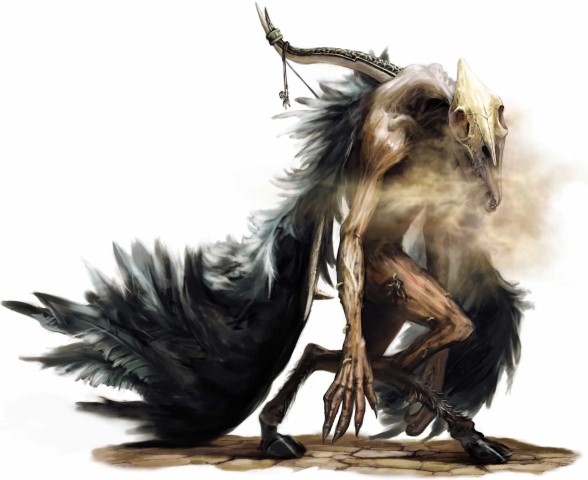
We do have options, here; yugoloths going back to their roots as daemons, of which the leukodaemon is obviously the spookiest. You’ve got things like the aeons, primal neutral forces, and forces for good like the agathion (even I know enough Greek to get that etymology) and the archons and azata. Actually, since I bring up the azata, I should talk a little about the phylogeny of the Bestiaries.

I mentioned Dungeons and Dragons’ streamlining, and it is worth pointing out that Pathfinder follows that same tactic as well…but rather than slash the creatures, they just reshuffle them into a meaningful order. The azata cover what used to be eladrin—the ghaele and the bralani—as well as lillends. Heck, if it was me, I’d toss the couatl in there, as well. Similarly, if you can’t squint at the arbiter in the inevitable category and see a modron, well then you aren’t really trying.
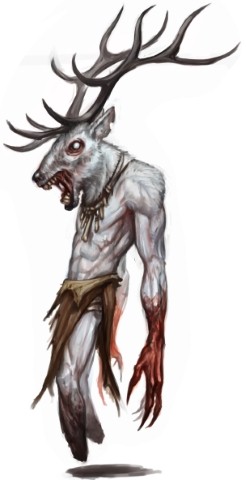
Stranger, more wicked things steal the show. I’m particularly fond of a few, like the akata, which are a mix of a foo lion and a xenomorph from Aliens, with a mane of tentacles. The girallon always make me happy; four armed apes are great! Thanks for reminding me of the critter from Broxo, while I’m at it. The horror movie creatures are some of my favorite, like the creepy attic whisperer; like the creepy kid from Ju-on with a fox skull for a head. Oh, the wendigo! This creepy guy. I pulled him out of a randomized box of miniatures recently and…gosh, he’s freaky.
I’m always a huge fan of what Pathfinder does with their golems, and I’m not let down here; the alchemical golem is like a walking Frankenstein’s laboratory, and the adamantine golem is sort of a cross between Marvel Comic’s Juggernaut and the tarrasque. Oh and Scylla and Charybdis! The latter looks like a giant isopod, but the former is like a mermaid with a body of…tentacles and wolf heads?
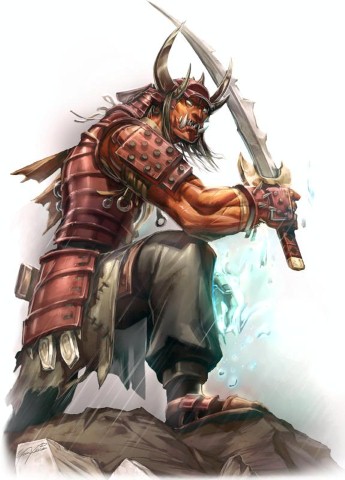
For me, monster design comes down to one simple trick: does it have a cool core mechanic? I have to admit, I find nothing so boring as a monster with no special abilities. A box of hit points that does 1d8 damage? Ugh, skip. Each monster should be a mini game, should have a twist that keeps the fight interesting and the players guessing. This can be as broad as the proteans’ reality twisting “warp waves” or even as simple as a breath weapon. It doesn’t have to be a power: the redcap’s weakness to religious symbols has the same effect. Presenting a hook for the fight is the key. Making a monster memorable requires a cool description and a cogent ecology—awesome art doesn’t hurt—but a mechanical flourish can really anchor the whole thing. As I said in my post about the World of Darkness’ embrace of non-canon, that is what I’m really looking for when I get a book. Inspiration…and a toolbox of rules and widgets.
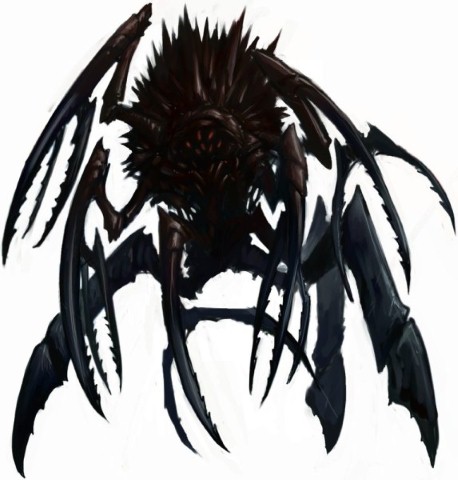
Of the two, Bestiary 2 is superior to the first Bestiary, for my purposes. This is for a simple reason: Bestiary is largely just a collection of the Open Game License creatures from the Monster Manual, cleaned up and reinterpreted. Some of the reimagined creatures are vastly superior to the original, and the “new” monsters are in points “old school” monsters, updated to Pathfinder, but most of the book’s beasts are old standards.
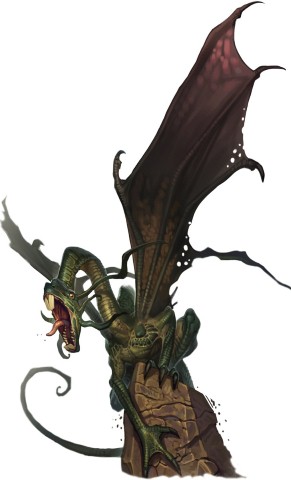
If you are just getting into the hobby, it is a must-buy, but Bestiary 2 follows the grand tradition of second sourcebooks in just getting crazy. As a fan of weird fiction, it scratches that itch. Heck, it scratches the science fantasy itch, as well as getting the “slasher flick” option out there. You could even stick to the Lewis Carroll monsters and have a beer and peanuts comedy game, if that is your style. Above all: options! Who doesn’t like new toys?
Mordicai Knode used a sleukodaemon to give one of his PCs leprosy recently; they had to get a Dune-esque heartplug to cure it. You can follow him on Tumblr and Twitter.










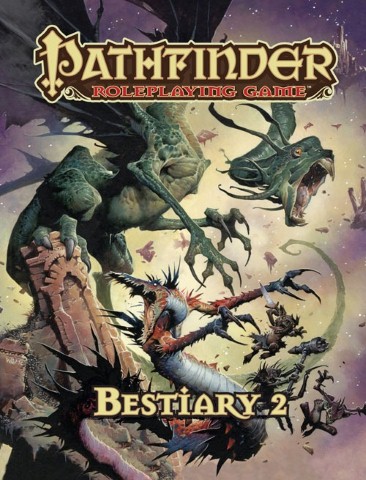
“Sleukodaemon” is a typo, but now I’m wondering what a sleukodaemon actually is…
OH MAN. reading your pathfinder articles always makes me want to play!
2. Kirk Keen
If you can’t find a game…MAKE ONE!
@1. mordicai
Not quite the same, but sleuco is a possible abbreviation of Sarracenia leucophylla – the carnivorous white pitcher plant.
Demon plant? I’d use it.
4. MatthewB
…uh, what, we’re totally onto something, pitcher plants are so weird &…sticky? There is totally something there!
Corpse Orgy.
I feel like if you’re an adventurer in a world where this thing exists you are the most fearless person.
I only just realized it’s a third party published monster.
STILL.
6. William Van Landingham
Hm. On the list of monsters that are on my “nuke it from orbit” list are stirges (in sufficient numbers) & gibbering mouthers (any).
Oh man is it hard for me to care about this. Having run the PF game for a year and too many 3.x games to merit mention – I have to say I was constantly and always reminded about how much better it was/is to DM the 4th edition.
First of all – the CR’s are garbage, they’re senseless – especially in the OGL sections – there’s situational modifications that would spike the CR or crush it depending on things like terrain or what-have-you. That’s part of being the DM – I’m aware, I agree – but you throw in some random encounters and there’s suddenly a lot of on-the-fly corrections having to happen.
The monsters themselves are just too identifiable – you can’t just reskin them as another creature as easily as you can in another game – owing to the weird (and seemingly senseless) suites of immunities and resistances that they have based on thier ‘types’.
Seriously – ban the idea of types. There are whole races of monsters? That’s what you’re saying? Then is it even really a monster? Are you just running genocide simulations?
Pictures are nice, I’ll grant you – some thought goes into powers and that’s fine too, I wouldn’t say – don’t buy these books to anyone – but really if you’re running Pathfinder – it’s next to useless as a resource for anything but a quick glimpse of what the monster might look like for the players.
As always – the rule of 10+ is the way to go with everything in D20 systems. 10+ Character level + 2/+4/+6 is the AC, the save bonus etc… Just scale everything to the characters’ level and you’ll have a good time – play with this book and you’ll have a confusing weird time.
I’d also like to mention that as big-bads and super-monsters go – none of these books really has one. A character at 17th level with the array of money and stats that the rulebook suggests can and will defeat the Terrasque in a single round.
Just… Just not useful and not worth having at the table when you play, leave it by the couch and glance at it for ideas, but only that.
9. Kingtycoon
It is true that I have a certain “outsider’s” view to this, as I run the World of Darkness mechanics. That being said, you’re “10+” scheme fails on what I was articulating as the core of good monster design– a clever power. CR balancing, bah! CR balancing is the epitome of “damned if you do, damned if you don’t” design. Balance the CR too well, & like 4e, you will be charged with running nothing more than iterations of a statistical simulator. Great, within a standard deviation of rolls, you will achieve normalized results! Have more “eyeballed” CRs & people will freak out about the monsters not being well balanced. Meh; me, I think the wiggle room is great– sometimes it WILL be too hard or too easy. Who can say! It probably depends on the party, ultimately.
@M #10
It’s cool to add powers to monsters and give them a neat twist – every monster should be the puzzle-monster – I agree with you. Let me get more specific about my complaints:
– The organization is frustrating and pointless – noting that a monster has ‘undead immunities’ is just cruel – say what they are, or at least note the page that they’re on. Those of us who play 3-4 weekly games of varied iterations and systems can’t always keep track of what rules addendum is in order at all times. Just write it down on the monster’s stat-block. And while you’re at it- try organizing the stat-block so that it’s legible and sensible to cusrosry glances. Really the stat-blocks could be done away with, the average hit points, armor class, etc… all buried in paragraphs of text – and it’d be about as useful a reference as any stat-block in these books. Basically, you have to copy out everything you need to know from the book before your session – if you want to use a monster from the book in the first place.
– The powers are out of whack with the CR that’s suggested -that’s my gripe. Some monsters have powers that will instantaneously kill the entire party (air-elemental I’m looking at you) while the CR in no way reflects that possibility. Fine with me if you want to just punish your players with varrying levels of cruelty – but varying levels of cruelty is not the notation that’s used – Challenge Rating is used and it just doesn’t reflect levels of challenge very well at all.
– There’s not a good sense of how these monsters can be used in a session. Not their ecological niche or world-building things like that, but rather – how many rounds of fighting will these monsters tend to cause? How much of the party’s resources will be consumed in terms of HP/Spells/Daily Abilities. If this book is supposed to be a real resource and not just a picture book for monster-slide-shows – it needs to incoprorate that kind of feature, that’s the sort of thing that helps you plan your sessions, build your encounters and make the next session the best session.
I don’t do PnP but it seems to me that not everything needs a ‘special power’ that makes it into a puzzle. Lions and tigers behave somewhat differently out of combat and are found in different places – does that mean only one such creature is allowed?
I’d have thought that 50% of creatures with special powers would be enough. Certainly I’d think that was plenty in a computer RPG (which should in principle be *more* about tactical combat, because that’s what computers do well.
11. kingtycoon
I mean, I get a lot of your concerns; it’s not for nuthin’ that I play World of Darkness mechanics & care about D&D Next. Or for that matter enjoyed the 4th edition as a tactical simulator; as a wargame, I thought it excelled. To me, the issues that you bring up just seem like…systemic OGL/Pathfinder/3e concerns? Which obviously a lot of people like playing…but maybe you don’t?
For me, mostly I am just looking at the puzzle-power, the widget, along with the art & the description. I don’t think I’m convinced by your argument– or I am half way, but then I disagree with your conclusions. How much of your party’s resources are going to be used? I think that requires generalizing resources in a way I’m not particularly fond of. The air elemental is going to be a different fight if you’ve got the guy with “dismissal” on his spell list, you know?
Though randomly– I kind of wish each monster has another, environmental “weird trick” with them. Like the air elemental might have a sidebar on including a vaccuum airlock in the fight, to complicate matters. Not required but just an idea. Or a, like, seige weapon in the golem stat block, for DMs who want to add some spice to the encounter. An optional idea.
I don’t do PnP but it seems to me that not everything needs a ‘special power’ that makes it into a puzzle. Lions and tigers behave somewhat differently out of combat and are found in different places – does that mean only one such creature is allowed?
I’d have thought that 50% of creatures with special powers would be enough. Certainly I’d think that was plenty in a computer RPG (which should in principle be *more* about tactical combat, because that’s what computers do well.
12. Gerry__Quinn
Well, I have two different things to say to that question.
One; yes! Maybe you should just have “Cat, Large” as the entry. You want it to be a lion, fine! Want it to be a tiger? Okay! Want it to be a banth, a Martian lion? No sweat!
Two; no! Lions & tigers should each have a unique power. Heck, maybe you should give lions a cool “roar & intimidate” power, & give tigers a neat “stealth” ability. Something! If I’m going to fight something I don’t want the fight to be “I roll, do I hit its AC, okay, I do 4 points; okay it rolls, does it hit my AC, okay, I take 4 points,” lather, rinse, repeat.
M-13 –
Okay, well I do have a problem with 3.x OGL stuff – yes. And I think it’s the half-measures that have been relied upon in those systems. I get that you’re reviewing a book and I’m reviewing a series of rules-systems so, sure we’ll diverge, we are bound to.
I think, and I believe you know this, that the HD/Type system for monster design is half-baked in the 3.x systems. The reality is that if you were going to go that direction, they should have abandoned the idea of HD altogether and just come up with monster levels and classes. Outsider, Animal, Ooze – heck, just think of the new doors that open when you’re designing a multiclass Ooze/Dragon – right? There is an element of this in the HD/Type design that’s been used, but it doesn’t go far enough (assuming you want to go that way) – because it doesn’t allow things like multiclassing and specialist feats etc… And really I’d say that the designers fell on their swords with that – because instead of a few bestiaries here and there, they could have had monster-building splat-books like they have for character classes/races – imagine how great that would be. Especially for the bottom line for these companies. Throw in the artwork, a few sample creatures – and point out that you can have a tiger, that is a tiger that is also a 1st level tiger or a 10th level tiger – you fall out of the unfortunate habits of making creatures of greater HD bigger – or Direr or draconic etc… No more messy templates!
The other direction is the direction that 4e went and I prefer it overall. Here is a stat-block, a set of math problems that has this relationship with the world – tactically – and here’s the main interaction that the players will have with it – it’s a brute, it absorbs damage and daily powers but doesn’t hit that bad… it’s artillery, it eats through HP and ranged attacks and so on but doesn’t usually suck up the dailies… Otherwise it’s up to you to skin the statblock in whatever material you want, it’s a series of interactions – it could be a dragon or a really tough ork or a robot – it’s up to you! Make it fit.
I realize that you don’t want to do that level of front-end bookkeeping and it’s not always that you want to premeditate the session to the point that you have confident guessess about where the players will be at the end of it – it’s not totally in line with the free form – but you can have an encounter or three or ten up your sleeve that will work a certain way, that will have puzzles and solutions and interactions that are defined – which you can swap in and out in a freeform game like yours. They aren’t fighting Orks today? Well, I bet that encounter you’ve got sketched out with the town-guards would work about as well, and hey, maybe later they make nice with the town-guards anyway – now you can use the encounter template for another scene, maybe involving the sewer vampires.
You get me? Encounter design > monster stats.
16. Kingtycoon
I like the idea of monster classes. Frankly– again, I can’t say this enough– what I want from a bestiary is a bunch of clever mini-game mechanics. Regeneration! Ooze splitting! Rust, why not, yes, even you rust! Curses, team work, whatever! This could easily be part of this “monster class levels” you discuss. Side note; please have them scale with PC levels, so I can make vampire PCs & dragonblooded PCs & Ooze Cultist PCs & whatever.
I highly disagree with the point hidden inside of your statement, & that is that stat blocks should be geared to encounters. No, I don’t like that…largely because my monsters (& villains) are not just crossbow turrets sitting in the middle of a dungeon guarding a pile of money. I want to know that Glabrezu can grant a wish a month. Suddenly, that dude has a real important campaign hook. The ecology & psychology of a monster is just as important.
Aha! But now you are exposed to the crazy-wisdom of the encounter-based adventure!
Because check this out: The VILLIAN can be DIFFERENT every encounter and still be the same guy!
True facts – you can have bad guys with whole new bags every session – keep them on their toes, keep them scared! Keep them in their place!
18. Kingtycoon
See, but that is different than my actual playstyle. I actually figure out what the players on the board can do. I run a character heavy game, & I am not too heavy with the railroad– a lot of times, PCs walk away from a villain, or an antagonist. Then they get to keep doing their thing, in the background. Which is why a system matters– so that the other pieces on the board are internally consistant!